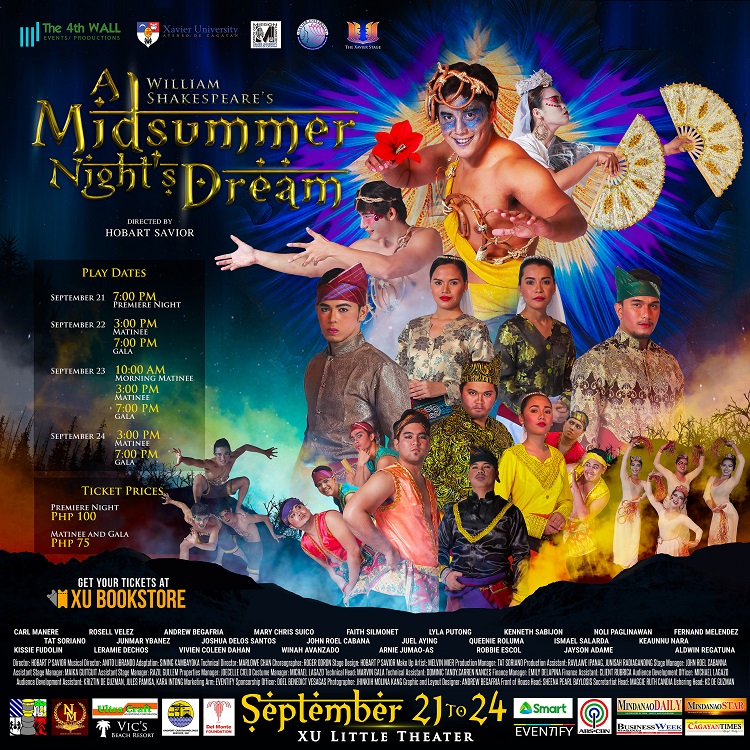
The Xavier Stage once again embarks on giving a twist to a classic play by adapting it in the Philippine context. William Shakespeare's A Midsummer Night’s Dream will be transformed into a Pre-Islamic Maranao setting. TXS’ performance of A Midsummer Night’s Dream has garnered positive reviews from various audiences since it was first staged in 2013 for its timeless Shakespearean substance fused with ancient Meranao culture and folklore.
Witness the beauty, dreams, love story, heartbreaks, fantasy, and adventures of Sultan Pata Kumilang, Samanodin, Masnar, Sohra, and Dayang together with the karibangs and tonongs from September 21 to 24 at the Xavier University Little Theater.
1. A Midsummer Night’s Dream is a love comedy written by the world’s highly celebrated playwright William Shakespeare. Various productions of his works have been mounted up to today celebrating the universality of his themes, his characters’ conflicts and triumphs, the exertion of human will, struggles, and fate that Shakespeare’s plays extend.
2. A Midsummer Night’s Dream as a theatrical production is categorized as a comedy which is believed to have been written between 1590 and 1597. Comedy as a genre amuses the audience with human, situational, and political follies. Comedies reflect interpersonal conflicts that are considered as incongruous. In A Midsummer Night’s Dream, ambitious and audacious pursuit to love and happiness is depicted. Since A Midsummer Night’s Dream is one of Shakespeare’s well-loved and popular comedies, the play shows us the excesses of romantic love and why pursue the right one to love amid all odds. This comedy seeks to counsel and to provide options as well as to entertain.
3. A Midsummer Night’s Dream in the context of Greek mythology from where Shakespeare took most of the allusion allows one to consider the expanse of Shakespeare’s imagination. Now with The Xavier Stage’s version as taken from the Sining Kambayoka Ensemble’s adapted script through its Script Production Project, the company sets A Midsummer Night’s Dream in Pre-Islamic Meranao introspecting the Meranao Folklore and Folk Tradition. In the TXS version, Shakespeare’s plot is retained but has been infused with Meranao folk characters. Theseus is now Sultan Pata Kumilang; Lysander is called Samanodin; Demetrius is called Masnar; Helena is called Sohra; and Hermia is known as Dayang. Pucks are called karibangs, Meranao version of male fairies or spirits who are mischievous, cunning, playful, and delights in playing pranks on mortals. The female fairies are called tonongs who are considered as guardian spirits among the Meranaos. In this version of A Midsummer Night’s Dream, the audience is exposed to Meranao myths as the literary device to reflect on and to forward Shakespeare’s thematic universality. This play facilitates the audience’s interest in discovering Meranao cultural tradition and also transcends in finding his or her own roots. This play is also a venue of introducing our own mythical tradition to the young generations of Filipinos.
4. The Xavier Stage’s version of A Midsummer Night’s Dream provides a visual treatment to the Meranao Material Culture, namely, their colorful costumes, props, and musical instruments.
5. The Cebuano language in poetic meter and rhyme schemes are playfully rendered as written in translation by Juanita Taladua- Riconalla, Edilberto Reyes, Roland Gohel, and Teodoro Drillon. The production has been duly recognized by the Sining Kambayoka Ensemble upon the approval of Professor Sunnie Noel and Pepito Sumayan.
6. This play is directed by Hobart P Savior. This production of Shakespeare’s A Midsummer Night’s Dream will also render posthumous credits to the late TXS musical director Paulo Javier Butalid Gener and actor Giovanni Tampus.
7. The Xavier Stage’s A Midsummer Night’s Dream has been featured as one of the major shows at the 8th Tanghal - University Theater Festival in 2014 and has been part of the Cultural Center of the Philippines’ Pasinaya Festival in February 2015. It was also presented at Lourdes College Coliseum for the benefit of the Archbishop James T Hayes Foundation in August 2014. ∎